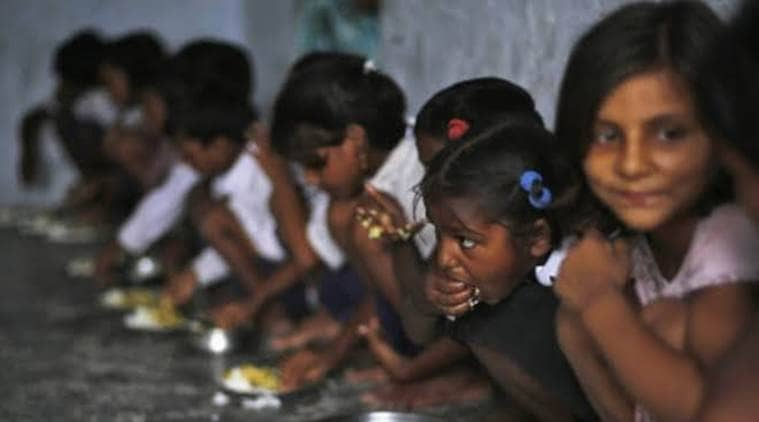 Pre-Covid, government schools in Karnataka were consuming about 47 tonnes of whole milk powder daily, or nearly 4 lakh kg per day (LKPD) of cow milk.
Pre-Covid, government schools in Karnataka were consuming about 47 tonnes of whole milk powder daily, or nearly 4 lakh kg per day (LKPD) of cow milk.
The shutting down of schools due to Covid-19 is affecting not only children, now unable to access cooked nutritious food under the Mid Day Meal (MDM) scheme, but also farmers for whom it provided an assured market.
An example is the Karnataka government’s Ksheera Bhagya scheme, which offers free milk over and above the MDM food entitlement. Under it, around 64 lakh children studying in 55,683 government schools from Classes 1 to 10, and another 39.5 lakh aged six months to six years in 64,000 anganwadi centres across Karnataka, are given 150 ml and 125 ml of milk, respectively, for five days of the week.
“The supplies to schools have totally stopped, while we continue to deliver to the CDPOs (child development project officers) in talukas (sub-districts). They deal with the village/ward level anganwadi workers, who are to go to beneficiaries even as their centres are shut,” said an official of the Karnataka Cooperative Milk Producers’ Federation (KMF).
Under Ksheera Bhagya, which had a budget of Rs 1,043 crore in 2019-20, the KMF makes whole milk powder available to schools and anganwadi centres. A school child’s 150-ml daily milk quota is made by adding hot water to 18 gm of the powder, while 15 gm is added in the case of the 125 ml for anganwadi beneficiaries.
Pre-Covid, government schools in Karnataka were consuming about 47 tonnes of whole milk powder daily, or nearly 4 lakh kg per day (LKPD) of cow milk. Along with the 35 tonnes (3 LKPD) by anganwadis, the offtake of 7 LKPD accounted for almost a tenth of the KMF dairy unions’ average procurement of 75.61 LKPD in 2019-20.
“We have clearly lost a market of 4 LKPD, even as our procurement itself has increased by 4 LKPD (from a peak of 84.44 LKPD in June last year, to 88 LKPD now). With normal sales also falling (due to the collapse of out-of-home consumption), our milk powder stocks have reached 18,000 tonnes and will further accumulate (with improved fodder availability from the monsoon rains),” the official admitted.
KMF unions are said to have slashed procurement prices for cow milk from Rs 29-30 to Rs 24-25 per litre since the March 25 lockdown. Also, farmers have reportedly not received the Rs 6/litre incentive – paid by the Karnataka government in addition to the procurement price – for the last three months.
Besides Karnataka, Gujarat has milk as part of MDM and ICDS (Integrated Child Development Services) programmes in schools and anganwadis. Its Dudh Sanjivani Yojana, serving 200 ml of fortified flavoured milk five days a week, covers about 30 lakh beneficiaries, with a budget provision of Rs 342 crore for 2020-21.
Dairy farmers aren’t the only ones losing out. Tamil Nadu and Andhra Pradesh offer five eggs a week as supplementary nutrition under the MDM, adding up to 160 for every schoolchild over 32 working weeks. Other states providing eggs in MDM include Telangana (thrice a week or 96 per child per year); Odisha, Chhattisgarh, Jharkhand, West Bengal and Tripura (twice or 64 annually); and Kerala, Bihar, Assam, Uttarakhand and Jammu & Kashmir (once or 32). They also supply to anganwadis, technically operating for 300 days a year: Telangana (7 eggs per week); Odisha (five), AP (four); Tamil Nadu, Jharkhand and West Bengal (three); Karnataka (two); and Bihar and Tripura (one).
“Andhra Pradesh and Tamil Nadu alone lift 55 lakh eggs daily, with Telangana adding another 30 lakh. All states put together procure up to 2 crore eggs under the MDM and ICDS, 7-8% of the country’s 25 crore per day production,” estimated Sanjeev Chintawar, Business Manager of the Hyderabad-based National Egg Coordination Committee.
According to him, the closure of schools has led to 70% of the 2 crore eggs per day market being lost.
“Recouping losses is more difficult for layer (egg) than broiler (chicken meat) farmers. A broiler bird is market-ready in 35-40 days from the chick-rearing stage, whereas a layer takes 18-20 weeks just to start producing and will give 400 eggs till its life cycle of 80 weeks. MDM-ICDS has a potential for consuming 6-7 crore eggs daily,” added Chintawar.